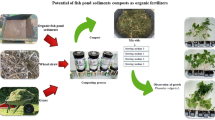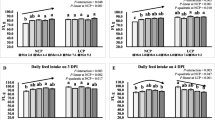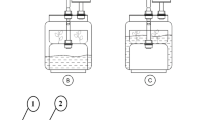Summary
The feeding requirements of earthworms have not been fully established. A vermiculite matrix was used to determine the dietary effects of various organic substances. Vitamins, DNA, and humic acid as additives improved growth and allowed reproduction of Eisenia fetida in a cellulose-based medium. Mature worms were not able to adapt to the medium and 20-day-old worms were used. Rates of growth and cocoon production were slightly less in a defined medium (7% organic content) than in a cow-manure control medium (70% organic content). The medium is likely to prove useful as a reference medium for obtaining biological information.
Similar content being viewed by others
References
Baya AM, Boethling RS, Ramos-Cormenza A (1981) Vitamin production in relation to phosphate solubilization by soil bacteria. Soil Biol Biochem 13:527–531
Bouwman H, Reinecke AJ (1987) Effects of carbofuran on the earthworm Eisenia fetida using a defined medium. Bull Environ Contam Toxicol 38:171–178
Cole L, Metcalf RL, Sanborn JR (1976) Environmental fate of insecticides in terrestrial model ecosystems. Int J Environ Stud 10:7–14
Edwards CA (1984) Report on the second stage in development of a standardized laboratory method for assessing the toxicity of chemical substances to earthworms. Commission of the European Communities: Environment and Quality of Life, Report EUR 9360 EN
Flack FM, Hartenstein R (1984) Growth of the earthworm Eisenia foetida on microorganisms and cellulose. Soil Biol Biochem 16:491–495
Graff O (1978) Physiologische Rassen bei Eisenia foetida (Savingy 1862) (Oligochaeta, Lumbricidae)? Ein Beitrag zur Frage der Domestikation dieser Art Rev Ecol Biol Sol 15:251–263
Hartenstein R (1982) Effect of aromatic compounds, humic acids and lignins on growth of the earthworm Eisenia foetida. Soil Biol Biochem 14:595–599
Kaplan DL, Hartenstein R, Neuhauser EF, Malecki MR (1980) Physicochemical requirements in the environment of the earthworm Eisenia foetida. Soil Biol Biochem 12:347–352
Lofs-Holmin A (1980) Measuring growth of earthworms as a method of testing sub-lethal toxicity of pesticides. Swed J Agric Res 10:25–33
Neuhauser EF, Kaplan DL, Malecki MR, Hartenstein R (1980) Materials supporting weight gain by the earthworm Eisenia foetida in waste conversion systems. Agric Wastes 2:43–60
Wenig K, Kubista V (1949) The presence of riboflavin in the luminous material of the earthworm Eisenia submontana. Experimentia 5:73
Author information
Authors and Affiliations
Rights and permissions
About this article
Cite this article
Bouwman, H., Reinecke, A.J. A defined medium for the study of growth and reproduction of the earthworm Eisenia fetida (Oligochaeta). Biol Fert Soils 10, 285–289 (1991). https://doi.org/10.1007/BF00337380
Received:
Issue Date:
DOI: https://doi.org/10.1007/BF00337380




